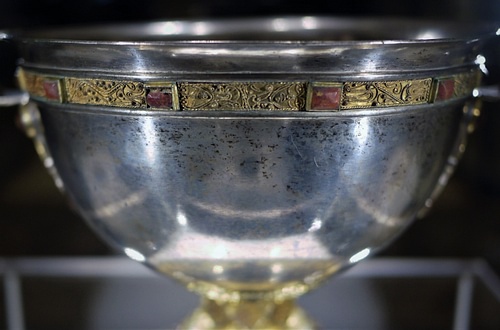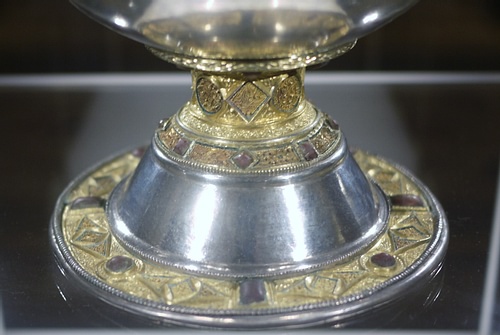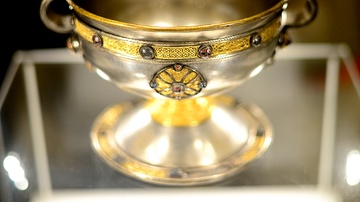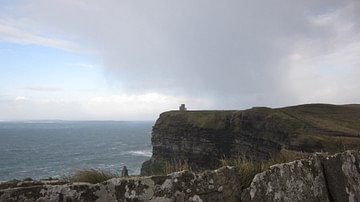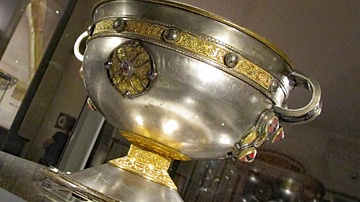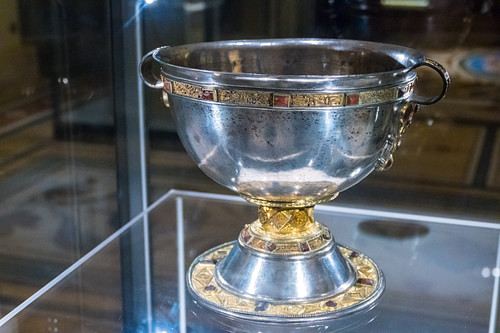
The Derrynaflan Hoard is a collection of Irish altar vessels dating between the 8th and 9th centuries CE. Discovered on the island of Derrynaflan, in the townland of Lurgoe, Co. Tipperary in 1980 CE, the pieces are now on display at the National Museum of Ireland: Archaeology in Dublin. The hoard consists of a silver paten used to hold communion during church celebrations, a bronze strainer, and a silver chalice decorated with gold filigree. This chalice is similar in style to the Ardagh Chalice, one of the most prized artefacts in Irish history. Made in the monastery at Derrynaflan, this impressive collection celebrates the Golden Age of Irish Art, during the early medieval period.
History of Derrynaflan Monastery
With the growth of Christianity in Ireland, monasteries became centres of education and learning, as well as religion, and were some of the wealthiest sites in the country. The monastery at 'Derrynaflan' is believed to have been founded in the 6th century CE by the Irish abbot Ruadhán of Lorrha. Meaning 'the wood of two Flanns', the two Flanns were co-patrons of the local area. The monastery might have been surrounded by marshy bogs but there were several tracks leading to and from the location and out into surrounding areas. It had strong ties with the churches of Lismore, Co. Waterford, and Emly, Co. Tipperary. This outside interaction would have increased the level of creativity and artistic skills of the monks living at the monastery.
The first recorded Viking attack in Irish history occurred in 795 CE, and raids continued over the next 200 years. Monasteries and churches were home to large collections of gold and silver liturgical vessels and became prime targets. Many decided to bury these collections underground and some of them have remained buried for centuries. It is not known whether this is the definite reason that the Derrynaflan hoard was buried, but is the most likely. It is thought to have been buried during the 10th century CE, during the time of the invasions. This is due to the evidence that the latest object in the collection, the Derrynaflan Chalice, dating from the early 9th century CE was only a little worn from use when it was buried. This suggests that it had not been made long before it was hidden underground.
In the second half of the 9th century CE, the monastery went into decline, which could have been a result of Viking attacks but could also have been due to the death of the patron of the monastery. The monastery is known to have been revived by the Franciscans, holding a small community there between 1676 and 1717 CE. On the site today are the ruins of an old church, most likely dating from the 13th century CE but little is known about the people that built it.
The Collection
The most impressive collections of Irish art dating back to this period were vessels used in the celebration of Mass, the centre of Christian worship. The beautifully decorated pieces of the Derrynaflan Hoard would have been reserved for special occasions and were found under a plain copper-alloy basin for protection. This basin has badly deteriorated, but it protected the artefacts underneath. While the strainer is worth mentioning, the chalice and paten are more impressive and two of the most treasured artefacts ever discovered during Irish excavation.
Chalice
Known as a calyx ministerialis, this type of chalice would have been used to hold wine during the celebration of Mass. Dating from the 9th century CE, it resembles the Ardagh Chalice in shape and design. The Ardagh Chalice is part of a hoard that also contains the much-celebrated Tara Brooch. Found buried in a potato field in Co. Limerick in 1868 CE, this hoard is appreciated a lot more the Derrynaflan Hoard, even though the pieces in both collections are just as impressive. The Derrynaflan chalice is a little smaller, with less intricate decoration, and the amber stones are a more muted colour.
The Derrynaflan Chalice stands at 19.2 cm (7.6 in) high, with a diameter of 21 cm (8.3 in) and consists of a beaten silver bowl and base joined by a copper-alloy pin. A handle is attached to each side of the bowl, with a band of gold filigree reaching around the bowl and another around the base plate. The most common images on these filigree panels are animals and beast heads, including wingless griffons and dogs. The handles and stem are the most elaborately decorated parts, featuring circular and diamond-shaped filigree panels, rather than the straight bands around the base and bowl. There are 54 amber stones spread around the chalice for decoration.
As it dates from an earlier period, it is clear that the Ardagh Chalice was the inspiration behind the design of the Derrynaflan Chalice. This demonstrates the ties that Derrynaflan had with surrounding monasteries. The style of the Ardagh Chalice was most likely based on the design of common Byzantine and western chalices, showing that the inspiration behind medieval design often came from other countries. The act of hammering and spinning the silver bowl goes back to the creation of hanging bowls in Ireland, which dates back to the 6th century CE.
Paten
The level of technical ability and artwork displayed on this paten is of the same quality as the Ardagh Chalice. It has even been suggested that these two pieces must have been made in the same workshop, although it has not been proven. Communion would have been placed on this flat dish during Mass celebrations, and it is the only surviving early medieval large paten in Europe. It is dated back to the 8th century CE. It follows the tradition of Eucharistic Plates, which were very large around this time. As the Middle Ages wore on, smaller plates that were made to sit around the rims of chalices, became more popular.
Consisting of over 250 separate pieces, the Derrynaflan Paten measures 37 cm (14.6 in) across and is made of beaten silver trimmed with silver wire mesh. The surrounding border on the upper surface is made up of 12 filigree panels, each with an enamel stud inside, similar to those surrounding the chalice. The Christian symbol of the cross can be seen on each of these studs. On the side, there are another 12 panels, holding inlaid red, blue, and yellow enamelled studs.
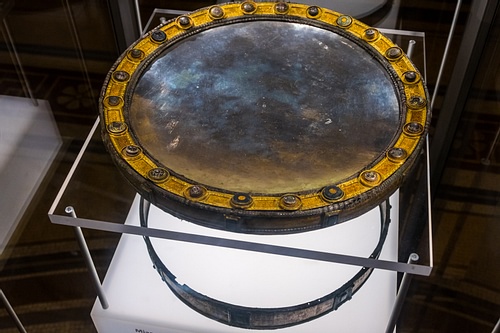
The gold wire on the panels forms zoomorphic images, such as eagles and serpents. The eagle could represent Jesus Christ, who was sometimes seen as an eagle in early Christianity. Triskeles and kneeling men are other images found on these panels, featuring the Celtic patterns of spirals and scrolls. This wire is finely knitted together, with images of the same quality as those on the Ardagh Chalice. These panels are pressed onto gold and silver foil, bordered by copper and silver wire.
Strainer
The third piece is a more everyday item. This copper alloy liturgical wine strainer ladle dates to the 8th century CE. Wine would have been poured through the strainer to remove any impurities before it was released into the chalice. Measuring 11.5 cm (4.5 in) across, it is surrounded by a rim of silver foil, with some enamelled studs added to the strainer plate. This simple design can be seen on a large number of functional vessels used in both religious ceremonies and everyday life during the medieval period.
Discovery
The Derrynaflan Hoard was discovered in 1980 CE by Michael Webb and his son Mike, while they were out on the island of Derrynaflan using metal detectors. Under the National Monuments Act of 1930 CE, a preservation order made it illegal for anyone to damage or interfere with the ruins of the site. While the owner of the land allowed these men to use a metal detector on the site, it was still illegal for them to dig up their findings. After detecting a strong signal, they decided to dig it up anyway.
Michael Webb states:
It could have been an old basin disintegrated but we decided to open it up and have a look to see if there was anything worthwhile… The goldwork, even then stood out remarkably well. It was beautiful. Then, I realised it was something very special. (RTE)
The piece they first unearthed was a bronze basin, taking it out to discover the chalice, strainer and paten underneath. Knowing the rules of the act passed in 1930 CE, they decided to keep their discovery secret for a few weeks before contacting the National Museum.
Post-Discovery
Although the Webbs were offered a reward of IR£10,000 ($15,000), they recognized the similarity to the Ardagh chalice and argued that this collection was worth more like IR£5 million ($7.5 million). Several court cases took place to determine the rightful owner, as well as the net worth of the collection. In 1986 CE, the value of this hoard was estimated at IR£5.5 million ($8.4 million), concluding that the family could keep it unless the museum was willing to pay this amount of money to take possession. The museum went on to make an appeal. In 1987 CE, the Supreme Court finally ruled that this hoard was the property of the state, and it was put on display at the National Museum. They still agreed to present the family with an award of IR£50,000 ($75,000) for finding it. The collection was taken over to the British Museum for restoration.
The discovery of the Derrynaflan Hoard went on to increase the popularity of metal detecting in Ireland, with enthusiasts inspecting random locations as well as recognised archaeological sites. In 1987 CE, the National Monuments Amendment Act was passed, making it illegal for anyone to search for archaeological objects using detecting devices unless they held a license. In 1994 CE, another National Monuments Amendment Act declared state ownership of archaeological objects and made it an offence to trade these objects or fail to report an archaeological discovery.
Conclusion
In 1986 CE, an excavation took place, concentrating on the area around the church. Findings included bronze and iron stick pins, bone combs, and fragments of a piece of sheet bronze decorated with an engraved foliage pattern. Over time, the ownership of the land has changed hands, but the state still has guardianship of the monastic site. Today, the site is free to visit and the ruins of a church and a single wall from another historic building can be seen. It has become an annual site of pilgrimage and a dawn Mass is celebrated here on Easter Sunday every year.
In 1989 CE, the Derrynaflan Chalice was included in an exhibition at the British Museum in London, named “The Work of Angels: Masterpieces of Celtic Metalwork, 6th-9th Centuries AD”. The entire hoard is now on permanent display at the National Museum of Ireland: Archaeology in Dublin.
While many medieval sculptures remain in their original location and illuminated manuscripts made in Ireland are found scattered across Europe with the most famous Book of Kells on display at Trinity College, this is not the case with the expensive gold and silver artefacts that were made in monasteries. A large number of these pieces were taken over to Scandinavia during the Viking attacks and it is unknown how many pieces had been hidden underground for safety purposes and remain undetected.
